
Answer
HW problem 5.7 Math 504. Spring 2008. CSUF
by Nasser Abbasi
Problem

Answer
Part (A) First note that
 and
and
 .
.
Let us define
 as the event
as the event
 ,
then we
write
,
then we
write
But by conditioning on state of the chain at time
 instead of time
instead of time
 ,
we write Note_1
,
we write Note_1

But
 by definition, and
by definition, and
 ,Therefore
the above
becomes
,Therefore
the above
becomes
Since
 and
and
 ,
we can rewrite the above as follows
,
we can rewrite the above as follows
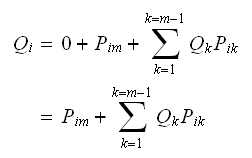 If we examine the sum more closely, we see it is a product of a vector and a
matrix. Since if we expand for few terms we see
that
If we examine the sum more closely, we see it is a product of a vector and a
matrix. Since if we expand for few terms we see
that
Which can be written as

Let
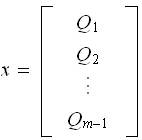 and let
and let
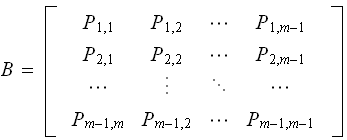 ,
and let
,
and let
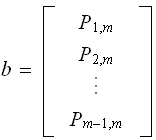 ,
then the above can be written
as
,
then the above can be written
as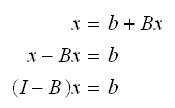 Where
Where
 is the identity matrix of order
is the identity matrix of order
 .
Now let
.
Now let
 .
hence
.
hence

Therefore we can find
 (which is the
(which is the
 )
if we can solve the above. i.e. if we can invert the matrix
)
if we can solve the above. i.e. if we can invert the matrix
 (i.e.
(i.e.
 is non-singular)
is non-singular)
Now we need to show that
 is invertible. Recall that a Matrix
is invertible. Recall that a Matrix
 is not invertible if we can find a vector
is not invertible if we can find a vector
 such that
such that
 .
.
Let us assume that
 is not invertible. Hence there exist a vector
is not invertible. Hence there exist a vector
 such that
such that

In other
words Now we show that it is not possible to find such a vector
Now we show that it is not possible to find such a vector
 ,
showing that
,
showing that
 must therefore has an inverse.
must therefore has an inverse.
We can always normalized the vector
 in (1) without changing this relation, hence we assume
in (1) without changing this relation, hence we assume
 is normalized such that its largest component
is normalized such that its largest component
 has length
has length
 (we do this by dividing the vector by the largest component it had). Now (1)
can be written in component form as follows
(we do this by dividing the vector by the largest component it had). Now (1)
can be written in component form as follows
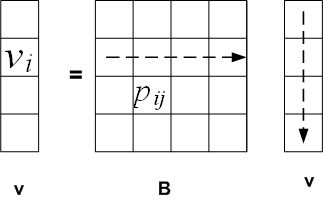

Since
 is normalized, it will have at least one component which is
is normalized, it will have at least one component which is
 in value, and it can have components which are less than
in value, and it can have components which are less than
 in value (we proof this part below). Let the set of the indices of those
components of
in value (we proof this part below). Let the set of the indices of those
components of
 which are
which are
 be the set
be the set
 and let the set of the indices of those components which are less than
and let the set of the indices of those components which are less than
 be the set
be the set
 .
In other
words
.
In other
words
First, we show that the set
 can not be empty: Proof by contradiction. Assume
can not be empty: Proof by contradiction. Assume
 is empty. Hence every element in the vector
is empty. Hence every element in the vector
 is
is
 .
Let us pick one of these elements
.
Let us pick one of these elements
 such that
such that
 corresponds to a row number in the matrix
corresponds to a row number in the matrix
 where this row happens to sum to a value less than
where this row happens to sum to a value less than
 .
Then we
write
.
Then we
write
But since this row sums to less than one, then the RHS above is less than 1. Hence this is a contradiction, hence
 can not be empty
can not be empty
Now that we showed the set
 is not empty, we can write (2) as a sum over the set
is not empty, we can write (2) as a sum over the set
 and the set
and the set
 of indices. (We know the set
of indices. (We know the set
 is not empty by definition, since the vector
is not empty by definition, since the vector
 is normalized, so it will have at least one element in the set
is normalized, so it will have at least one element in the set
 ).
Hence (2)
becomes
).
Hence (2)
becomes
Let us again pick one of those
 components which has value
components which has value
 (we know there is at least one of these), and try to see if this equality
holds for this row
(we know there is at least one of these), and try to see if this equality
holds for this row
 .
So (3)
becomes
.
So (3)
becomes
But all the
 in the set
in the set
 have value
have value
 ,
so the above can be
simplified
,
so the above can be
simplified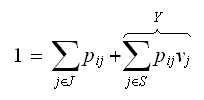 Now each
Now each
 in the term labeled
in the term labeled
 above is less than
above is less than
 (since it is the set
(since it is the set
 ),
so this means
),
so this means
 ,
therefore the sum in (4) could never add to
,
therefore the sum in (4) could never add to
 if there are values
if there are values
 that are non-zero when
that are non-zero when
 is in the set
is in the set
 .
(since the sum
.
(since the sum
 is being reduced from its original row sum). So for (4) to be satisfied, we
need to have all the
is being reduced from its original row sum). So for (4) to be satisfied, we
need to have all the
 when
when
 is in the set
is in the set
 .
.
 is zero
is zero
What this means is that if
 ,
then the
,
then the
 row
in the matrix
row
in the matrix
 must have zero entries in the columns which correspond to the indices in the
set
must have zero entries in the columns which correspond to the indices in the
set
 As shown in this diagram as an example
As shown in this diagram as an example
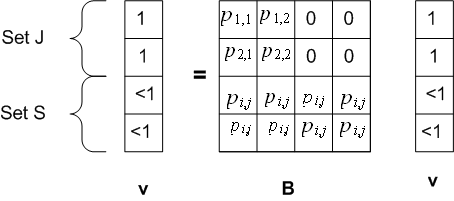
In
the above diagram, I showed one example of the conclusion of above argument.
Of course the set
 the way I drawn it does not have to be 'contiguous', it could be in any
pattern, as say the following
the way I drawn it does not have to be 'contiguous', it could be in any
pattern, as say the following
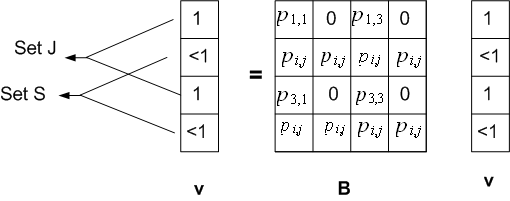
Therefore,
we see that
 when
when
 correspond to a state whose number is the same as the index value in the set
correspond to a state whose number is the same as the index value in the set
 ,
and
,
and
 is a state whose number correspond to a state whose number is the same as the
index value in the set
is a state whose number correspond to a state whose number is the same as the
index value in the set

What this means is that it is not possible to reach states that correspond to
indices in the set
 from states which correspond to indices in the set
from states which correspond to indices in the set

 it is not possible to leave this set.
it is not possible to leave this set.
But this is the same as saying the matrix
 contains a closed subset. In other words,
contains a closed subset. In other words,
 is reducible. However, this is not possible, since the matrix
is reducible. However, this is not possible, since the matrix
 is taken from a subset of a chain which is irreducible, i.e. it contains no
closed subsets, but we found at least one such subset.
is taken from a subset of a chain which is irreducible, i.e. it contains no
closed subsets, but we found at least one such subset.
Therefore, we conclude that our assumption which lead to this is invalid.
Therefore, there exist no vector
 such that
such that
 .
Hence
.
Hence
 does have an inverse. QED
does have an inverse. QED